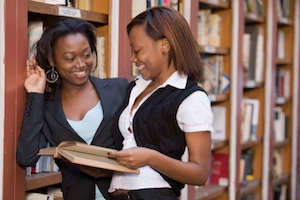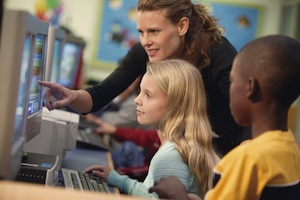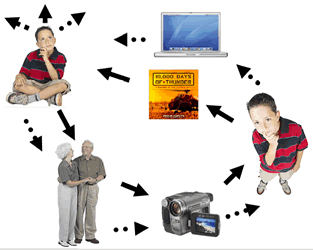Partnerships & Programs
At the completion of this section, you should be able to:
- identify the library's community of learners
- discuss approaches to collaboration
- describe examples of library partnerships for information instruction
- describe audiences for public library programming
Begin by viewing the class presentation in Vimeo. Then, read each of the sections of this page.
Explore each of the following topics on this page:
- A Community of Learners
- A Culture of Collaboration
- Faculty Partnerships
- Embedded Librarians
- Public Library Programming
- Resources
A Community of Learners
 Making an information literacy program work school or university-wide requires planning and careful implementation and evaluation.
Making an information literacy program work school or university-wide requires planning and careful implementation and evaluation.
To be effective in meeting the needs of a diverse student population, the librarian must be able to apply a variety of teaching and learning strategies. Peer teaching, classroom teaching teams (with and without the librarian), as well as parental and community collaborations are all part of this process.
Effective leadership for change is difficult and involves a complex process of interdependent components (Fullan, Bertani, & Quinn, 2004). It's the responsibility of the librarian to create an atmosphere for inquiry. Barbara Stripling in Curriculum Connections through the Library (2003, p. 29-33) describes four areas that support a community of inquiry:
- Learner-Centered. School librarians help students become independent learners by designing environments responsive to divergent individual needs, interests, and perspectives. These environments provide opportunities for collaboration. Students become both independent and interdependent by participating in active learning environments focusing on activities such as learning beyond the classroom (i.e., nature centers, museums, community oral history projects).
- Knowedge-Centered. A coherent approach to knowledge links the indepth learning in one classroom with other situations and learning opportunities. Multiple resources and varied perspectives help students connect to prior knowledge and build accuracy, complexity and sophistication of their ideas.
- Assessment-Centered. Assessment involves more than testing, students are observed throughout the learning process including before, during, and after.
- Community-Centered. Students need to be involved in learning communities that support and also challenge their thinking.
Barbara Stripling in Curriculum Connections through the Library (2003, p. 33-36) identified four roles librarians assume to support in-depth inquiry learning:
- Catalyst. Librarians act as change agents provoking and supporting school change. They design and co-teach throughout the curriculum. The librarian can provide a whole-school perspective through activities such as curriculum mapping. Offering opportunities for professional development is another way the librarian can impact the thinking of teachers.
- Connector. The librarian connects with individual teachers and groups of teachers through collaboration. Inquiry is enhanced through conversation and sharing.
- Coach. Librarians facilitate the development of independent and responsible learners through activities such as "think-alouds" and modeling. When teachers assess student progress continuously, steps can be taken to address individual needs.
- Caregiver. A personalized approach can reach individual teachers and students. The librarian is responsible for creating a safe, nurturing and supportive atmosphere for inquiry.
A Culture of Collaboration
 Librarians have different approaches to collaboration. Some jump right in and see themselves as an integral part of the teaching staff while others see themselves in the role of supporting individual student inquiry.
Librarians have different approaches to collaboration. Some jump right in and see themselves as an integral part of the teaching staff while others see themselves in the role of supporting individual student inquiry.
The skills of the classroom teacher and the teacher librarian complement each other. It makes sense to combine your areas of expertise and resources to design a rich learning environment for students. Rather than teaching skills in isolation, seek out ways to bring your teachers together for interdisciplinary, inquiry-based experiences.
In Grade 4 students' development of research skills through inquiry-based learning projects, Chow (2008) and other describe the benefits of moving to an inquiry-based learning approach. They found that collaboration among the classroom teachers, the information technology teacher, and the school librarian was important to success of the program. The study stressed the role of teachers and librarians as facilitator, advisor and guide. As a result of the inquiry-based approach, student projects were found to be of higher quality.
Collaboration is a partnership that involves shared responsibility for designing and developing instructional materials as well as implementing instruction. This partnership extends to teaching, supervision, and assessment. Planning and teaching activities often occur along a spectrum from support and cooperation to interdependence and collaboration. In some cases, teachers are immediately receptive to the idea of collaboration. However in other situations it may take years of cooperation before a collaborative relationship develops.

Lance, Rodney, and Schwarz (2010) conducted a series of studies that focused on collaboration. They found that 90% of administrators identified collaboration on instructional design and delivery as "essential or desirable." Nearly half of teachers and librarians stated that they didn't initiate instructional collaboration. There seems to be a disconnect between the value of collaboration and the implementation. The study found that when administrators value collaboration, information skills competencies increase.
Virginia Rankin (1999, p. 4) stresses the difference between the ideal and real world.
"In the best of all possible worlds, every teacher would approach me well before the start of an assignment. Together we would identify instructional goals and assessment criteria to reinforce those goals. We would discern prerequisite skills and knowledge and divide instructional responsibilities. At the completion of the assignment we would review what went well and what went poorly, and make plans for what we might do differently new time.
In my less-than-ideal world, I have often considered myself lucky to receive any prior notice at all of an upcoming assignment. For a while, I found consolation in the few partners who did ask for my help when their research projects were nothing more than vague ideas just beginning to gel. One day I realized I would make more progress if I relaxed a bit about my ideal for collaboration. I did not expect my students to master a new skill instantly or to progress at the same speeds. Why should I expect this of teachers? I began to see teachers as ranged along a continuum of collaboration and I began to believe I could move them along that continuum."
Before jumping into a collaborative project, consider ways to build a culture of collaboration in your school. This involves opening communication, building trust, allowing time, and becoming proactive.
 Try It!
Try It!
Examine the Making a Video Critique of an Information Source assignment.
How do these activities reflect collaborative planning?
 Read!
Read!
Read The Culture of Inquiry in School Libraries (PDF) by Carol A. Gordon in School Libraries Worldwide (January 2010, Volume 16, Number 1, 73-88.
A Positive Atmosphere for Learning
The librarian is smiling, the teachers are confident, the students are excited to learn, and the entire building is energized. According to Mihaly Csikszentmihalyi, a professor of psychology from the University of Chicago, this total immersion in learning can be described as a flow state. The entire learning community is fully absorbed in engaging activity.
A positive atmosphere starts with both teachers and students being satisfied in the following areas: competence, belonging, usefulness, potency, and optimism (Sagor, Motivating Students and Teachers in an Era of Standards). According to Martin Seligman, director of the University of Pennsylvania Positive Psychology Center, three distinct routes to happiness have been identified: positive emotion and pleasure, engagement, and meaning. He stresses that it’s possible to be happier, more satisfied, and more engaged in life regardless of one’s circumstances
Support Each Other. Support each other through thanking peers for their work, encouraging each other, and sharing ideas. Use of blogs and online threaded discussions as well as face-to-face interactions to share "warm fuzzies".
Focus on the Positive. Share successes using tools such as electronic newsletters and classroom blogs.
Building Collaborative Relationships
 According to Haycock (1999), collaborative planning requires a knowledgeable and flexible teacher-librarian, with good interpersonal skills and a commitment to integrated information literacy instruction, and the active support of the principal.
According to Haycock (1999), collaborative planning requires a knowledgeable and flexible teacher-librarian, with good interpersonal skills and a commitment to integrated information literacy instruction, and the active support of the principal.
Collaboration starts with making contact. This connection may start with smiles in the hall or simple information gathering activities.
Personalities can have a tremendous impact on the ability of the librarian and teacher to work together. Differences in teaching styles, approaches to education, and even personal interests provide challenges for collaboration. Knowing how your teachers think and plan is essential in facilitating collaborative activities.
Carol Ann Tomlinson is best-known for her work in the area of differentiated instruction to meet the individual needs of students. She has recently begun stressing the need to consider how teachers differ in readiness, interest, and learning profile. In other words, just as each child is unique, each teacher has a unique set of interests and needs. As you begin creating collaborative relationships, keep in mind the principles of differentiation.
Optimizing collaborative relationships involves identifying eclectic opportunities that reach the varied planning and teaching style of each educator while still addressing the primary goal of impacting student achievement.
In addition to knowing your teachers. Paula Montgomery found the the cognitive style of the media specialist also makes a difference in collaboration. In her study, Cognitive Style and Level of Cooperation between the Library Media Specialist and Classroom Teacher, Montgomery concluded that "Knowledge and awareness of cognitive style may be useful to individuals for purposes of self-management. By knowing one's own style, one can expand on its strengths and learn techniques for mitigating the negative aspects or weaknesses. If one knows that one has a tendency toward extreme field dependence, one can learn methods for structuring one's environment with such devices as outlines, time lines, and questioning techniques."
In her article Understanding How Teachers Plan: Strategies for Successful Instructional Partnerships, Linda Lachance Wolcott (1994) states that "library media specialists must assume a more proactive and involved role in planning curriculum and instruction; they must work in partnership with teachers. A successful instructional partnership hinges on the library media specialist's understanding of the planning process as teachers see and practice it. Collaborative planning is the library media specialist's survival skill—a skill that becomes even more important as the concepts of information literacy, lifelong learning, and resource-based learning propel us into a third revolution." Based on research, she drew the following conclusions:
- Teachers plan for different reasons.
- There are different types and styles of planning.
- Planning is a mental activity.
- Teachers' planning is nonlinear.
- Planning is influenced by published curriculum materials.
Wolcott suggests the following strategies as a guide to working in partnerships with teachers:
- Together, reflect on teaching and learning.
- Approach the planning process from the teachers' perspective.
- Accommodate various types and styles of planning.
- Provide the leadership.
In her article How to Pester Your Teachers, Debra Logan (2000) stresses strategies for developing teacher contacts such as listening for openings, expanding low-level "pull a collection" into skills-based projects, anticipating projects, and surveying teachers. She also suggests sharing materials and links with the suggestion of expanding these ideas into projects.
 Read!
Read!
Read Revising the “One-Shot” through Lesson Study: Collaborating with Writing Faculty to Rebuild a Library Instruction Session by Shevaun E. Watson, Cathy Rex, Jill Markgraf, Hans Kishel, Eric Jennings, and Kate Hinnant (2013).
Collaborative Planning
Information linkages maps can be developed by librarians during the revision of collaborative instructional units. For example, as the teacher librarian and classroom teacher reflect on their digital oral history projects, they wonder how the unit could be enhanced to go beyond simply video recording a family story. They identify specific standards related to using nonfiction resources, distinguishing fact from opinion, and understanding different perspectives on historical events as areas they wish to emphasize.
Digital Oral History Collaboration Information Linkages Map. Click to Enlarge.
The teaching partners begin by reflecting on the current student inquiry assignment as shown by the solid arrows in the Figure above (Click to enlarge the figure). Students begin by identifying a person they’d like to interview and developing effective interview questions. Next, they conduct their interview using technology to record and edit stories. Then, students generate questions about the time period related to the interviews and use nonfiction books to address these questions. After examining this process, the teachers decide to add another cycle. This proposed cycle is shown by dotted lines. Equipped with new information and ideas, students may wish to develop additional interview questions for the same person or interview others who experienced the same time period. As students gather and edit these new interviews, they are asked to identify the fact, fiction, perspectives, and arguments found in these stories. Then, use other resources to make comparisons and extend the experience. An optional third round is also built into the lesson to allow for clarification of information and perspectives. The linkages map can be enhanced to include specific sources to be used in assisting students with particular information needs.
Information Fluency and the Curriculum
 Content area teachers and librarians must coordinate their efforts to achieve information fluency in their learners. For example, a language arts or social studies teacher might create an assignment that asks students to interview an adult about their career.
Content area teachers and librarians must coordinate their efforts to achieve information fluency in their learners. For example, a language arts or social studies teacher might create an assignment that asks students to interview an adult about their career.
This project might address a specific subject area standard. However without information skills related to conducting an effective interview, students will be unable to reach their content-area goal. In the same way, a media specialist can ask students to memorize interviewing techniques, but these strategies are meaningless without an authentic project.
Carol Kearney (2000) identified a series of steps in planning with teachers:
- Understand and work with teachers' different planning styles.
- Allow teachers to take the lead in the planning process and accommodate different styles of planning.
- Agree on clearly stated learning outcomes from the onset.
- Develop the essential questions based on the problem or issue being studied.
- Decide on appropriate assessment criteria and assessment formats.
- Design the learning activities based on the targeted learning outcomes.
- Link resources.
 Read!
Read!
Read Building Guided Inquiry Teams for 21st Century Learners by Carol Kuhlthau and Leslie Maniotes in School Library Monthly (January 2010). IUPUI login required.
Embedded Librarians
 While stand-alone information literacy courses and one-shot workshops continue to be popular, many librarians are increasingly embedding themselves and their curriculum into content areas.
While stand-alone information literacy courses and one-shot workshops continue to be popular, many librarians are increasingly embedding themselves and their curriculum into content areas.
In 2004, Barbara Dewey (2004, 5-17) began using the term embedded librarian to describe the activities of librarians who closely cooperate and collaborate with faculty, other individuals, and groups. She states that
"embedding requires more direct and purposeful interaction than acting in parallel with another person, group, or activity. Overt purposefulness makes embedding an appropriate definition of the most comprehensive collaborations for librarians in the higher education community."
Kvenild and Calkins (2011, vii) state that embedded librarians
"work closely over extended periods of time with non-librarian groups, whether by joining a semester-long course, maintaining an ongoing presence in online courses, participating in board curriculum planning efforts, or joining the staffs of academic departments, clinical settings, or performing groups."
Brower (2011) six characteristics of embedded librarianship:
- Embedded librarians collaborate with their users
- Form partnerships on the department and campus level
- Provide needs based on services
- Offer convenient and user-friendly services outside of library settings
- Become immersed in the culture and spaces of users
- Understand the discipline including the culture and research habits of their users
In a study of "at-risk" college students, Fisher and Heaney (2011, 41-42) found that
"during one-shot instruction sessions, at-risk students, especially, often hesitate to ask questions of someone who is unfamiliar. As they begin to feel a closer connection to librarians, however, instructors report that the students become more willing to seek advice about moving forward with their research."
Fisher and Heaney also found that students who had experiences with an embedded librarians exhibited the following behaviors:
- Greater willingness to ask questions about the research process.
- More focused research topics.
- Increase in follow-up consultations.
- Greater ownership of librarians, and an increased view of librarians as "teachers" and "consultants" rather than merely visitors to their courses.
- Greater appreciation for necessity of research.
In developing library collaborations with at-risk students, Fisher and Heaney (2011, 42-43) had the following recommendations:
- Recognize the affective perceptions of at-risk students.
- Work with instructors during the planning stages of assignment design.
- See the goal of information literacy instruction as process- rather than product-based.
- Seek opportunities to embed within learning communities.
- Consider location.
- Build in assessment of the embedded librarianship component.
In Integrating information literacy as a habit of learning - assessing the impact of a golden thread of IL in the curriculum, Bent and Stockdale (2009) stress that integrating skills into content areas is important.
"some aspects of IL can clearly be taught to all students in the same way, thereby allowing the development of generic supporting resources. Other aspects may be better learned in a specific disciplinary context. Considering the development of IL throughout the degree programme has led to a blend of teaching and learning approaches, using both generic and subject specific material as appropriate.
Integration of the development of IL throughout the programme means that while there are library-based skills sessions, these sessions cannot be identified as the sole, or even the main points where IL teaching and learning takes place. It is clear that the development of IL needs to be valued through direct credit-bearing assessment whenever possible to further highlight its importance to the students. If 'marks' or even self assessed rankings are attributed to IL abilities, this serves to challenge and motivate students towards improving their ranking in a later assessment exercise.
It is evident that embedding the reflective assessment of IL can play a crucial role in engaging students with the concepts involved, so that as well as learning specific skills, they have the opportunity to develop a wider awareness of the information environment. Measuring the impact of this approach also needs to be embedded alongside the activity. " (Bent & Stockdale, 2009).
Montiel-Overall and Grimes (2013) conducted a longitudinal study for teachers and librarians collaborating on inquiry-based science instruction. They found positive effects of this type of collaborative relationship on student performance.
Faculty Partnerships
Many school and academic information literacy programs focus on library-based activities and content. However, an increasing number of librarians recognize the importance of collaborating with faculty for the development of discipline specific programs.

Paterson and White (2012) documented a partnership between academic librarians and freshman English faculty to form an innovative Freshman Composition library instruction sessions. By combining their skills, they were able to move library instruction "beyond developing students' information-gathering expertise by focusing on the development of transferable knowledge and critical thinking skills."
 Read!
Read!
Read Guiding students from consuming information to creating knowledge by Susanne Paterson and Carolyn White.
Forming Partnerships
Social media and easy communication have made professional collaboration much easier than in the past. Whether collaborating with other librarians within a large library or working with librarians in other locations, large projects can be made more manageable through collaboration.
Let's explore some examples of partnerships.
In Designing and implementing an information literacy course in the humanities, Daugman, McCall, and McMahan (2012) expanded their introductory information literacy courses to include advanced level, discipline-specific offerings. Subject specialist librarians formed a team to develop a credit-bearing humanities course.
In A program for introducing information literacy to applied art and design students, Walczak, Reuter, and Sammet (2009) describe the process of developing a school-wide information literacy program. Their recommendations include involving librarians, faculty, as well as administration in the process. They also stress the importance of working with individual classroom teachers and providing faculty development.
In Business information literacy teaching at different academic levels: an exploration of skills and implications for instructional design, Gunn and Miree (2012) examined the information skills of business students. They found that the skills of freshman and senior level students were not significantly different indicating that students were not developing information skills through traditional business courses. They found that information literacy tutorials had a significant positive impact on student performance.
The findings suggest the need for collaboration between the librarian and business faculty to ensure that students acquire the necessary skills. Gunn and Miree found that discipline-specific topics are important. For instance in business research, students needed a "wider awareness" of publication types beyond standard academic articles. Examples in these areas are critical for understanding.
Subramaniam and others (2013) conducted a project involving collaboration between school librarians, science teachers and middle school students. The Sci-Dentity afterschool program involved youth in connecting science-infused media such as graphic novels and science fiction with science. The program was connected to both AASL and STEM standards.
Seek out innovative connections by looking for common interests within a school or university. For instance, develop relationships with writing centers, language laboratories, and other groups that typically work with students outside traditional classroom settings.
In Information literacy and writing tutor training at a liberal arts college, Cannon (2009) discusses collaboration between libraries and writing centers. She states:
"Librarians bring to the table the essential skills of finding sources and of evaluating those sources for authoritativeness and appropriateness. In turn, librarians can learn from tutors and writing center administrators more about writing pedagogy and process, providing a context for their work with student research. Librarians can interact with the writing center at several points, one of those being early on in peer tutor training. Such training could include any of the five aspects that define information literacy: a) recognizing the information need, b) finding, c) evaluating, d) using information, and e) ethical considerations." (Cannon, 2009, 53)
It's important to consider relationships that are mutually beneficial.
"At the most fundamental level, any interaction between librarians and the writing center reinforces the concept that writing and research are intertwined processes. When these processes work together effectively, based on sound principles of information literacy, they model the best in learning and critical thinking." (Cannon, 2009, 53)
Angell and Tewell (2013) found that academic librarians can successfully partner with local high schools to develop information literacy skills. Sustained opportunities were found to be more effective than one-shot sessions. They found that this approach bridges the gap between high school and college.
 Read!
Read!
Read Angell, Katelyn & Tewell, Eamon (2013). Collaborating for academic success: a tri-institutional information literacy program from high school students. Public Services Quarterly, 9, 1-19.
Public Library Programming
 Whether working with the local genealogy society or the business association, public libraries must reach outside the library when developing innovative programs.
Whether working with the local genealogy society or the business association, public libraries must reach outside the library when developing innovative programs.
In Lifelong Learning in Public Libraries, Gilton (2012, 35) describes the types of library instruction that occur in public libraries:
- Outreach to teachers, parents, scholars, business people, people in institutions, unemployed people, and other groups
- Instruction in combination with other programming and activities, such as literacy and book discussion groups
- Information and referral services connecting people to local organizations and agencies
- Networking with schools, institutions, and organizations
- Reader's advisory and other services to independent and lifelong learners
- Indirect, asynchronous instruction
- Promotion of new technologies to the public, including computer and Internet instruction to elders and other adults
- Electronic networking with other organizations, businesses, and especially the government to connect people to technology
Gilton (2012, 175) stresses that programming should reflect the evolving needs of patrons "from cradle to grave (or from hatch to dispatch), looking at preschoolers and their caregivers, families, schoolchildren and teens, young people in transition, adult learners, and elders."
Resources
Angell, K., & Tewell, E. (2013). Collaborating for academic success: A tri-institutional information literacy program for high school students. Public Services Quarterly, 9(1), 1-19.
Bent, M. and Stockdale, E. (2009). Integrating information literacy as a habit of learning - assessing the impact of a golden thread of IL in the curriculum. Journal of Information Literacy. 3(1), pp. 43-50. Available: http://ojs.lboro.ac.uk/ojs/index.php/JIL/article/view/PRA-V3-I1-2009-4
Brower, Matthew (2011). A recent history of embedded librarianship: collaboration and partnerships building with academic learning and research environments. In C. Kvenild & K. Calkins (eds.), Embedded Librarians: Moving Beyond One-Shot Instruction. ACRL, 3-16.
Cannon, Kelly, Jarson, Jennifer (2009). Information literacy and writing tutor training at a liberal arts college. Communications in Information Literacy, 3(1), 45-57.
Chu, Sam, Chow, Ken, Tse, Shek-kam, and Kuhlthau, Carol C. (January 2008). Grade 4 students' development of research skills through inquiry-based learning projects. School Libraries Worldwide, 14(1), 10-37.
Csikszentmihalyi, M. (1997) Finding Flow: The Psychology of Engagement with Everyday Life. Basic Books.
Csikszentmihalyi, M. (1990) Flow: The Psychology of Optimal Experience. Basic Books.
Darling-Hammond, Linda (1997). The Right to Learn: A Blueprint for Creating Schools that Work. Jossey-Bass.
Daugman, Ellen, McCall, Leslie, and McMahan, Kaeley (2012). Designing and implementing an information literacy course in the humanities. Communications in Information Literacy, 5(2).
Dewey, Barbara (2004). The embedded librarian: strategic campus collaborations. Resource Sharing & Information Networks, 17(1/2), 5-17.
Fisher, Rick & Heaney, April (2011). A faculty perspective: strengthening at-risk students' transition to academic research through embedded librarianship. In C. Kvenild & K. Calkins (eds.), Embedded Librarians: Moving Beyond One-Shot Instruction. ACRL, 35-45.
Fullan, Michael, Bertani, Al, & Quinn, Joanne (April 2004). New Lessons for Districtwide Reform. Educational Leadership. 61(7), 42-46.
Gilton, Donna L. (2012). Lifelong Learning in Public Libraries. Scarecrow Press.
Gordon, Carol A. (January 2010). The culture of inquiry in school libraries. School Libraries Worldwide, 16(1), 73-88.
Gunn, M. and Miree, C. E. (2012). Business information literacy teaching at different academic levels: an exploration of skills and implications for instructional design. Journal of information literacy, 6(1), 18-34.
Kearney, Carol A. (2000). Curriculum Partner: Redefining the Role of the Library Media Specialist. Westport, CT: Greenwood Press.
Kuhlthau, Carol & Maniote, Leslie (January 2010). Building Guided Inquiry Teams for 21st Century Learners. School Library Monthly, 18-21.
Kvenild, Cassandra & Calkins, Kaijsa (eds.) (2011). Embedded Librarians: Moving Beyond One-Shot Instruction. ACRL.
Lance, Keith Curry, Rodney, Marcia J. & Schwarz, Bill (June 2010). Collaboration works -- when it happens! Teacher Librarian, 37(5), 30-36.
Latham, D., Gross, M., & Witte, S. (2013). Preparing teachers and librarians to collaborate to teach 21st century skills: Views of LIS and education faculty. School Library Research (SLR), 16, 1-23.
Logan, Debra (2000). How to Pester Your Teachers.
Montgomery, Paula Kay (1991). Cognitive Style and Level of Cooperation between the Library Media Specialist and Classroom Teacher. SLMQ, 19(3).
Montiel-Overall, P., & Grimes, K. (2013). Teachers and librarians collaborating on inquiry-based science instruction: A longitudinal study. Library & Information Science Research, 35(1), 41-53.
Paterson, Susanne F. & Gamtso, Carolyn White (2012). Guiding students from consuming information to creating knowledge. Communications in Information Literacy, 5(2).
Rankin, Virginia (1999). The Thoughtful Researcher.
Sagor, Richard (2003). Motivating Students and Teachers in an Era of Standards. ASCD.
Seligman, M. E. P., & Csikszentmihalyi, M. (Eds.). Handbook of Positive Psychology. Oxford University Press.
Seligman, Martin E. P (2002). Authentic Happiness. Free Press.
Seligman, Martin E. P. & Steen, Tracy A. (July/August 2005). Positive Psychology Progress: Empirical Validation of Interventions (PDF). American Psychologist, 60(5), 410-421.
Stripling, Barbara (2003). Inquiry-Based Learning. In Curriculum Connections through the Library, edited by Barbara Stripling and Sandra Hughes-Hassell. Libraries Unlimited, 3–40.
Subramaniam, M., Ahn, J., Waugh, A., Greene Taylor, N., Druin, A., Fleischmann, K. R., & Walsh, G. (2013). Crosswalk between the Framework for K–12 Science Education and Standards for the 21st-Century Learner: School librarians as the crucial link. School Library Research (SLR), 16, 1-28.
Walczak, David A., Reuter, Monika E., and Sammet, Diane L. (2009). A program for introducing information literacy to applied art and design students. Communications in Information Literacy, 3(2), 193-203.
Wolcott, Linda Lachance (1994). Understanding How Teachers Plan: Strategies for Successful Instructional Partnerships. SLMQ, 22(3).

